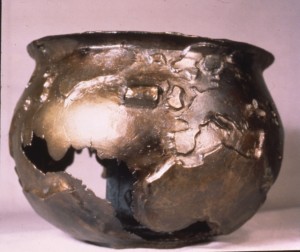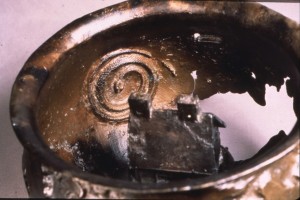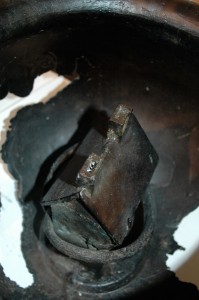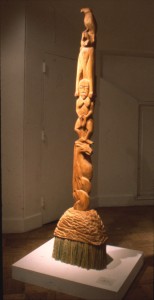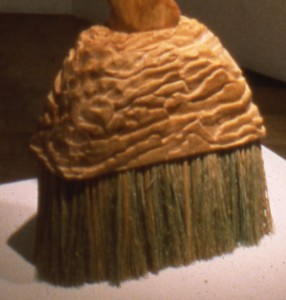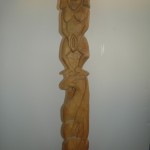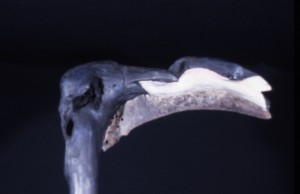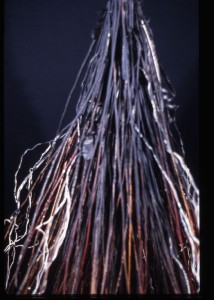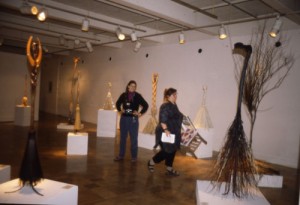Happy Autumn!
Available! $1000
Turning from Brooms for a while, I’d like to present one of Rae’s Cauldrons. She did 3 while at the UW, with access to the foundry there. The theme was the elements, and she did Fire, Water, and Earth. This one is the Earth. The outside is a globe, with the continents in relief. Visible in this picture are North Africa and Europe., with one of the loops intended for a ring handle that was never installed.
All 3 cauldrons were created using the”lost wax” method. To get the basic shape, Rae started with a beach ball. She had an old deep-fryer, looked like a toaster with juse one very large slot. Into this were placed hunks of foundry wax, a brown, sticky substance that dries not quite as hard or brittle as paraffin. It can be carved with clay tools, and layers built up with melted wax in a variety of ways. Rae used the pot of just-barely melted wax, butter knives and palette knives, and brushes. To make the cauldron shape, she brushed layer after layer of wax onto the beach ball, 3/4 of the way up, letting it cool before adding another coat. For the Earth Cauldron, the entire orb was fairly thin, about 1/4″.
I printed out some maps of the continents, we cut them out, and laid the patterns on a 3/8″ thick slab of foundry wax, then cut through the wax to get little pancakes of each. These were transferred to the surface of the orb, warmed almost to melting to make them flexible, stuck by heating a thin pallette knife over an alcohol flame. The beach ball was deflated, the top edge folded over and formed into a lip
This piece also features snakes. Snakes had special significance to Rae. They stood for Wisdom and knowledge. Rather than try to carve snakes from scratch, she bought
some rubber snakes from a toy store. Since they were burnable material, they were incorporated directly into this piece. (I’ll describe how the Fire Cauldron’s feet were made later) One was curled up on the bottom, and is very seldom seen, since you have to tip the cauldron over. The others are inside, one on the inside surface of the globe, the other curling around the other feature inside the cauldron, the House.
The house is modeled after the quilt pattern called “schoolhouse”. Again, a sheet of wax (molten wax poured into a lined cookie sheet) was cut into the 4 sides, roof, and then 2 “smokestacks”, complete with windows and doors. Assembled and placed in the bottom of the cauldron, and then another snake out a window, curled around and into the door. The house had a lot of significance to Rae, representing home, a sanctuary usually, but the snake moving in and out represented the invasion of that sanctuary, a reference to some unpleasant childhood memories.
Once the piece was complete, more wax was added as “sprues”, for the bronze to pour into the mold, nd to allow venting of gasses when everything melted. The entire piece was suspended in a cylindrical cardboard tube, and plaster poured into and around it. When that hardened, what was left showing was a 3″ circle of wax and a couple of small ones for vents. The entire thing was placed into a burn-out oven for a couple of days, where all the wax was evaporated, along with the snakes and a few plastic straws, etc.
While that was still hot, the bronze was melted into a crucible, and some heat-suit wearing art students working on the semester’s projects poured it into the waiting molds, while others stood by with shovels and gloves. The molds were placed in black foundry earth, a slightly sticky mix of sand, dirt, waste oil, and other stuff, if my memory serves me.
There was a problem. A crack had appeared in the mold, and the molten liquid found it and widened it, and out the side of the mold appeared flames and smoke. Rushing in with shovels, dirt was piled against the side and held in place with shovels, which turned red with the heat. As more bronze was poured in, more flowed out till George (the Instructor) said enough!
When it had cooled enough to open up, the cauldron had a large, irregular fan of bronze coming off the side, and several places wehre the bronze had not completely filled in the thinner areas, because it had cooled too qucily spreading into them. Thus the round-edged gaps in the oceans visible in the photos. The effect was unexpected, unplanned, but not unpleasant.
Then began the long process of cleaning up the cauldron. The sprues had to be cut off, as well as the excess bronze that had leaked out. A sawzall and angle-grinder did most of the work. Hours and many blades, several grinding disks, then sand paper. The result was a shiny, golden miracle. Then the patina.
Rae read about, and experimented with, several types of patinas (finishes) for the bronze. For the Earth cauldron, she selected a fired milk/mud application. The cauldron was taken to a friends farm, a pit dug, a fire mad, and the cauldron put into the coals. dirt was mixed with milk and poured into the cauldron, and the pit, and the cauldron lowered into the hole and covered with more dirt, more milk. Interesting smell.
The result is a deep brown with darker spots, and a semi-gloss finish. So it remains to date.
